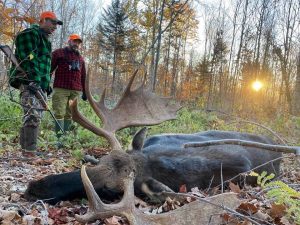More Moose Permits

By: Lee Kantar
The spruce budworm outbreak of the 1970s created widespread moose habitat across the commercial forestlands of Maine spurring an increase in moose numbers through the late 1990s. While this was great for moose hunters and wildlife watchers alike, animal populations that grow too dense can create problems when too many animals are sharing the same space.
In Maine, the number of calves born each year has dropped significantly since the 1990s as well as the number of twin calves produced. With winters moderating, resulting in two weeks less winter and extended summers (Maine Climate council), the prevalence of the winter tick has increased dramatically causing moderate to high mortality in calves trying to make it to their 1st birthday.
Winter Ticks
The winter tick is a one-year cycle tick that specializes in attacking moose (>50,000 ticks/moose) and blood loss can result in the death of young or small animals. After seven years of research in Maine and putting GPS collars on over 600 moose, the department has documented the impact of the winter tick on our moose.
More moose equals more winter ticks, fewer calves produced, and fewer calves surviving to their 1st birthday. MDIFW is proposing to take management action in half of a Wildlife Management Unit to determine whether increased moose harvest can help break the winter tick cycle.
During our research, winter tick has been highlighted extensively in the news. The department has been asked over and over about ways to rid the moose woods of winter tick. This has included spraying the forest with pesticide, spraying the moose with pesticide, placing medicated salt licks, and darting/collaring moose from the helicopter to apply medication, or tick collars. MDIFW listens and evaluates these measures.
In short, none of these are effective, realistic, or economical. Why? MDIFW does not own the commercial forest lands moose thrive on. There is no current effective pesticide to put on moose or across the forestlands to kill winter ticks.
Capturing and putting tick collars or powder or spray on moose would be extraordinarily costly and dangerous. There is no way to capture enough moose and repeat it with the same moose to be effective. One potential exists that can be applied over a large area, moose hunting.
Modern Moose Hunt
Moose hunting is a sustainable, important management tool. For 40 years, the modern Maine moose hunt has played an important role in hunters’ lives providing meat, recreation, family time, and tradition to thousands of people across the state. Maine moose hunting permit numbers have been very conservative ensuring plenty of moose for wildlife viewing as well as hunting. Today, facing climate change and high winter tick abundance, moose numbers in many areas remain too high for their own health.
Most winters, calves as well as adults suffer horribly from the scourge of winter tick infestations. Often resulting in slow, lingering death for overwintering calves and reduced body condition in adult cows causing reproductive stress. Research across the global moose range shows that lower density moose populations are healthier populations. Lower density populations produce more calves and have less disease and most notably, fewer parasites including the winter tick.
MDIFW is proposing to test whether lowering moose densities in a small portion of the core moose range can decrease the number of winter ticks and improve the production and survival of calves (6%; covering half of Wildlife Management District 4. This would be done by increasing cow permits on the western half of WMD 4.
The number of additional cow permits issued will depend on this winter’s aerial population counts but is likely to be in the hundreds. The department proposes conducting this increased hunt over five years during which time we will continue to monitor the moose and tick population thru GPS collaring 8-month-old calves, conducting aerial surveys, and collecting harvest data on reproduction and winter ticks.
The Harvest Quota
The department terms this an “Adaptive Unit” because we will be actively monitoring and assessing the moose population as we implement the increased harvest. Therefore, we can adjust permits during the time period as well as evaluate progress. When moose numbers have been lowered, the department would likely decrease the permit numbers as we analyze whether winter tick numbers have decreased and whether calf productivity and survival increases.
The goal for this will be to determine whether the increased cow harvest can make a difference or not? If it makes a difference, then we would continue to keep the population in check by adjusting permit levels, if not, permit levels would likely decrease to previous levels or slightly higher consistent with objectives put forth in the 2017 Big Game Management Plan (MDIFW).
As an agency responsible for the conservation and management of Maine’s wildlife it is critical to apply the best available science to problems that are identified on the ground. As the Adult Cow and Calf Survival Project illuminated the biological impacts from winter tick, so to can implementing this Adaptive approach to moose management demonstrate whether proactive management actions can improve moose health and conditions on the ground.
Seldom do the resources, information, and call to action align to determine the best management practice to take before inaction makes it unnecessary. In other words, winter tick is here and impacting our moose. If we wait to act and years go by, we risk losing more moose by parasites when we could have determined whether we could make a difference now.
_____________
Lee Kantar is the State Moose Biologist, Maine Department of Inland Fisheries and Wildlife (MDIFW).
For more articles about hunting, fishing, and the great outdoors, subscribe to the Northwoods Sporting Journal.
